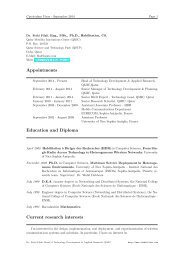Performance Analysis of the Actuator Discovery Protocol ... - Fethi Filali
Performance Analysis of the Actuator Discovery Protocol ... - Fethi Filali
Performance Analysis of the Actuator Discovery Protocol ... - Fethi Filali
You also want an ePaper? Increase the reach of your titles
YUMPU automatically turns print PDFs into web optimized ePapers that Google loves.
40<br />
35<br />
30<br />
Actor 1<br />
Actor 2<br />
Actor 3<br />
Actor 4<br />
Actor 5<br />
Number <strong>of</strong> Sensors<br />
25<br />
20<br />
15<br />
10<br />
5<br />
0<br />
0 100 200 300 400 500 600 700 800 900 1000<br />
Time (in sec.)<br />
Figure 7: Cluster Densities avg_speed = 1-m/s, pause_time 20s, Tx_range = 11 m, distance d (between any<br />
two nodes) = 10 m<br />
as shown in Figure 10 even in <strong>the</strong> course <strong>of</strong> mobility due to <strong>the</strong> periodic update<br />
<strong>of</strong> multi-hop paths. The total network energy consumed during <strong>the</strong> lifetime <strong>of</strong> <strong>the</strong><br />
SANETs is considerably low with ADP compared to previous proposed coordination<br />
protocols.<br />
4 Conclusion and Future Work<br />
For sensor-actuator coordination, <strong>the</strong> proposed ADP can acquire a promised QoS<br />
for time stringent traffic at <strong>the</strong> cost <strong>of</strong> optimal energy consumption. For actuatoractuator<br />
coordination, <strong>the</strong> proposed unified framework using AODV can be exploited<br />
by different applications to always select <strong>the</strong> best networking paradigm<br />
that is possibly available according to <strong>the</strong> sensed information and to perform <strong>the</strong><br />
necessary operations in an efficient way. The issues related to node-failures and<br />
mobility are well handled by <strong>the</strong> periodic exchange <strong>of</strong> ’Hello’ messages in all deployment<br />
scenarios. The energy consumption for obtaining new paths in-case <strong>of</strong><br />
failure is also energy efficient and is driven by <strong>the</strong> collaborative nature <strong>of</strong> SANETs.<br />
For <strong>the</strong> moment, we are working on <strong>the</strong> design <strong>of</strong> a delay-energy sensitive<br />
routing protocol to work in collaboration with our ADP, to make <strong>the</strong> architectural<br />
and coordination platform sound for <strong>the</strong> future <strong>of</strong> SANETs. We are also working<br />
on MAC optimization based on <strong>the</strong> proposal for <strong>the</strong> efficient utilization <strong>of</strong> sensorenergy<br />
and to satiate <strong>the</strong> real-time problems experienced so far in <strong>the</strong> SANETs.<br />
References<br />
[1] M. Farukh Munir and F. <strong>Filali</strong>, A Novel Self Organizing Framework for SANETs, to appear in Proc, <strong>of</strong><br />
8





